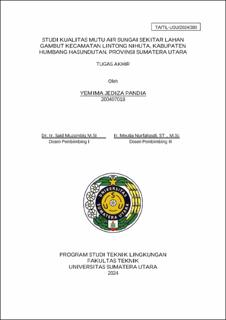Studi Kualitas Mutu Air Sungai Sekitar Lahan Gambut Kecamatan Lintong Nihuta, Kabupaten Humbang Hasundutan, Provinsi Sumatera Utara
Study on River Water Quality Around the Peat Lands of Lintong Nihuta District, Humbang Hasundutan District, North Sumatra Province

Date
2024Author
Pandia, Yemima Jediza
Advisor(s)
Muzambiq, Said
Nurfahasdi, Meutia
Metadata
Show full item recordAbstract
River water comes from springs or comes from rainwater. A river is a stream of water that flows
and extends continuously from the upstream point, which is the highest part of the river channel
and is the initial source of water to the downstream point, which is the lowest part and is close to
the estuary to the sea. Peat swamp areas cause water conditions to become polluted. Peat water
has a low pH, high heavy metal content, and high TSS, TDS, BOD and COD values. The research
carried out was limited to finding out the effect of stripping and utilization on the influence of river
water in polluted peatland areas. To determine the determination of river water quality around
peatlands. Testing water quality in rivers around peatlands uses the parameters temperature, pH,Pb, TSS, TDS, DO, BOD, COD, Total Coliform. Based on the research results above, it can be
concluded that there are 12 parameters that have exceeded the applicable quality standards,namely PP No. 22 of 2021 for class II, namely Temperature, TDS, TSS, Turbidity, Color, Ph, BOD,COD, DO, Nitrate, Manganese and Total Coliform. Based on the analysis values that have been obtained, the water quality status in the river drainage is: a. Pollutant Index Method: Lightly Polluted b. STORET Method: Heavily Contaminated. Based on the analysis values that have been obtained, the river water quality status is: a. Pollutant Index Method: Lightly Polluted b. STORET Method: Heavily Contaminated. The results of research on river water quality parameters that exceed quality standards are pH, BOD, DO and Total Coliform. The river water quality status is 6 (six) sampling points using the Pollutant Index method with Lightly Polluted conditions, while the results of groundwater quality research are 6 (six) sampling points using the STORET method with Heavily Polluted conditions
Collections
- Undergraduate Theses [404]
